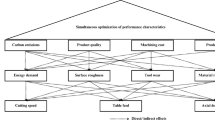Abstract
Mass finishing process is employed to improve the surface characteristics of aerospace components. The quantity of material removed and power consumed during mass finishing depend on the effect of various input process variables such as workpiece material, media deployed, process time, etc. Often in manufacturing lines, the process parameters are determined by trial-and-error approach, which results in increased material wastage and power losses. Hence, an optimization of input process parameters is of utmost importance from environmental standpoint. This requires formulation of a generalized and an explicit mathematical model. In the present work, the power consumption and material removal rate (MRR) in mass finishing process are studied using Gene Expression Programming (GEP) and artificial neural network (ANN) techniques. It was found that the proposed models were able to generalize the output characteristics of mass finishing process. The parametric and sensitivity studies showed that the media factor has the maximum influence on the power consumption and MRR. Hence, media factor needs to be optimized for achieving better environmental performance of mass finishing process.
Similar content being viewed by others
References
Balogun VA, Mativenga PT (2013) Modelling of direct energy requirements in mechanical machining processes. J Clean Prod 41:179–186
Chandrasekaran M, Muralidhar M, Krishna CM, Dixit US (2010) Application of soft computing techniques in machining performance prediction and optimization: a literature review. Int J Adv Manuf Technol 46:445–464
Mukherjee I, Ray PK (2006) A review of optimization techniques in metal cutting processes. Comput Ind Eng 50:15–34
Bhushan RK (2013) Optimization of cutting parameters for minimizing power consumption and maximizing tool life during machining of Al alloy SiC particle composites. J Clean Prod 39:242–254
Emami M, Sadeghi MH, Sarhan AAD, Hasani F (2014) Investigating the Minimum Quantity Lubrication in grinding of Al 2O3 engineering ceramic. J Clean Prod 66:632–643
Campatelli G, Lorenzini L, Scippa A (2014) Optimization of process parameters using a Response Surface Method for minimizing power consumption in the milling of carbon steel. J Clean Prod 66:309–316
Pande SS, Patel SM (1984) Investigations on vibratory burnishing process. Int J Mach Tool D R 24:195–206
Uhlmann E, Dethlefs A, Eulitz A (2014) Investigation of material removal and surface topography formation in vibratory finishing, in: Procedia CIRP, 6th CIRP International Conference on High Performance Cutting, HPC2014, Berkeley, pp. 25–30
Mohajerani A, Spelt JK (2009) Edge rounding of brittle materials by low velocity erosive wear. Wear 267:1625–1633
Domblesky J, Evans R, Cariapa V (2004) Material removal model for vibratory finishing. Int J Prod Res 42:1029–1041
Uhlmann E, Dethlefs A, Eulitz A (2014) Investigation into a geometry-based model for surface roughness prediction in vibratory finishing processes. Int J Adv Manuf Technol 75:815–823
Boschetto A, Bottini L, Veniali F (2013) Microremoval modeling of surface roughness in barrel finishing. Int J Adv Manuf Technol 69:2343–2354
Hashimoto F, Johnson SP (2015) Modeling of vibratory finishing machines. CIRP Ann Manuf Technol 64:345–348
Hashemnia K, Spelt JK (2014) Particle impact velocities in a vibrationally fluidized granular flow: measurements and discrete element predictions. Chem Eng Sci 109:123–135
Mohajerani A, Spelt JK (2010) Numerical modeling of the edge rounding of brittle materials by vibratory finishing. Wear 268:1002–1012
Ciampini D, Papini M, Spelt JK (2009) Modeling the development of Almen strip curvature in vibratory finishing. J Mater Process Technol 209:2923–2939
Naeini SE, Spelt JK (2009) Two-dimensional discrete element modeling of a spherical steel media in a vibrating bed. Powder Technol 195:83–90
Hashemnia K, Spelt JK (2015) Finite element continuum modeling of vibrationally-fluidized granular flows. Chem Eng Sci 129:91–105
Zhao D, Ni W, Zhu Q (2014) A framework of neural networks based consensus control for multiple robotic manipulators. Neurocomputing 140:8–18
Zhao D, Zhu Q, Li N, Li S (2014) Synchronized control with neuro-agents for leader-follower based multiple robotic manipulators. Neurocomputing 124:149–161
Koza JR (1992) Genetic programming: On the programming of computers by means of natural selection, MIT Press, Cambridge
Ferreira C (2001) Gene expression programming: a new adaptive algorithm for solving problems, arXiv preprint cs/0102027
Alavi AH, Gandomi AH (2011) A robust data mining approach for formulation of geotechnical engineering systems. Eng Comput (Swansea, Wales) 28:242–274
Gandomi AH, Alavi AH (2013) Expression Programming Techniques for Formulation of Structural Engineering Systems. In: Metaheuristic Applications in Structures and Infrastructures., pp 439–455
Vijayaraghavan V, Garg A, Wong CH, Tai K, Singru P (2015) An integrated computational approach for determining the elastic properties of boron nitride nanotubes. Int J Mech Mater Des 11:1–14
Vijayaraghavan V, Garg A, Lam J, Panda B, Mahapatra SS (2015) Process characterisation of 3D-printed FDM components using improved evolutionary computational approach. Int J Adv Manuf Technol 78:781–793
Garg A, Bhalerao Y, Tai K (2013) Review of empirical modelling techniques for modelling of turning process. Int J Model Identif Control 20:121–129
Garg A, Tai K (2012) Review of genetic programming in modeling of machining processes. In: Proceedings of 2012 International Conference on Modelling, Identification and Control, ICMIC 2012, Huazhong University of Science and Technology, Wuhan, pp. 653–658
Gandomi AH, Alavi AH, Ting TO, Yang XS (2013) Intelligent modeling and prediction of elastic modulus of concrete strength via gene expression programming. In: Lecture Notes in Computer Science (including subseries Lecture Notes in Artificial Intelligence and Lecture Notes in Bioinformatics)., pp 564–571
GEPSOFT, GeneXproTools, Version 5.0, http://www.gepsoft.com (2014)
Garg A, Vijayaraghavan V, Wong CH, Tai K, Sumithra K, Mahapatra SS, Singru PM, Yao L (2015) Application of artificial intelligence technique for modelling elastic properties of 2D nanoscale material. Mol Simul 41:1143–1152
Author information
Authors and Affiliations
Corresponding author
Rights and permissions
About this article
Cite this article
Vijayaraghavan, V., Castagne, S. Sustainable manufacturing models for mass finishing process. Int J Adv Manuf Technol 86, 49–57 (2016). https://doi.org/10.1007/s00170-015-8146-3
Received:
Accepted:
Published:
Issue Date:
DOI: https://doi.org/10.1007/s00170-015-8146-3




